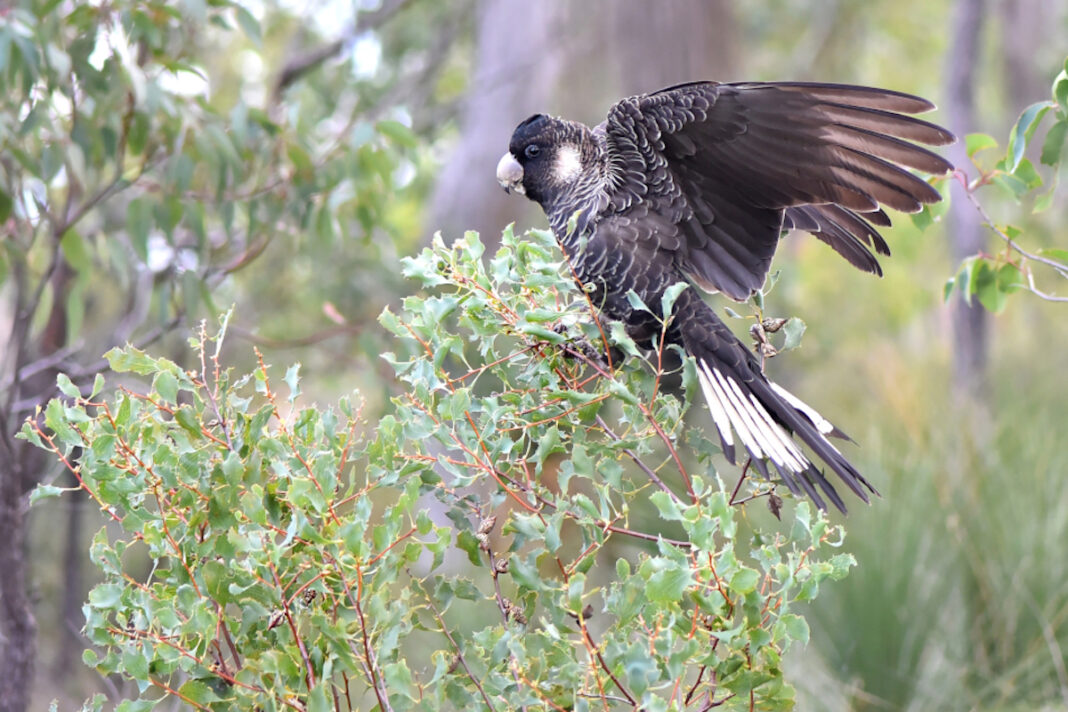Australia’s black cockatoos are magnificent creatures that urgently require monitoring: not always easy as they range through the forest. DAVID WAUGH reveals how technology is shedding essential light on the Carnaby’s cockatoo in its restricted range in SW Australia
OUT of sight, but not out of mind. Exactly what are those Carnaby’s cockatoos (Zanda latirostris) doing when they have disappeared from view and cannot be observed directly? Until now we could only guess, but technology and ingenuity have now brought us to the point where not only can we remotely follow their movements across the landscape, but we can also detect from beyond the horizon some of their behaviours. The research to achieve these advances has been conducted over recent years with three black cockatoo species in south-west Western Australia (see reference).
Out of those species, one of the two most threatened with extinction is the endangered Carnaby’s or short-billed black cockatoo. It is found only in the south-western corner of Australia and, due to habitat fragmentation, loss of nest hollows and lack of native food sources, scientists estimate that the population is half of what it was 45-50 years ago.
The current best estimate of the total population is 34,000 individuals, and the steep population decline has triggered conservation action by government, civil society and NGOs. One of the latter is Bush Heritage, and since 2020 the Loro Parque Fundación has been supporting its very encouraging habitat restoration project. Focused on the Monjebup Reserve of Bush Heritage, the project aims to reconnect native habitat fragmented by land cleared for agriculture.
The sandplains of this region have a native shrubland habitat dominated by plants of the flowering Proteaceae family, especially of the genera Banksia, Dryandra, Hakea and Grevillea. The seeds of these shrubs are an important food source for the cockatoos. The project has already made gains in expanding the foraging habitat, so much so that Carnaby’s cockatoos have returned to the Monjebup area to forage in the new zones of proteaceous-rich vegetation spread across 400 hectares. Within the restoration area, camera-traps and sound recorders have been installed to monitor the activity of the cockatoos.
These devices have already shown their usefulness, but technology can offer another advance in monitoring the wild cockatoos. The research undertaken on the black cockatoos of this part of Western Australia began with an assessment of the feasibility of using tail-mounted satellite tags (transmitters) to track rehabilitated Baudin’s cockatoos (Zanda baudinii) released back to the wild. The tags proved to be reliable, even allowing one cockatoo to be tracked for more than 250km (155 miles) from the release site. The study demonstrated that satellite tags can be a useful tool for locating and tracking forest black cockatoo species which are otherwise difficult to track and monitor.
The satellite tag is glued to the base of the shaft of a central tail feather so that the antenna lies parallel to the feather. The tag will drop from the cockatoo when the feather moults. To maximise the amount of data collected, it makes sense to attach the tag closer to the beginning rather than at the end of the feather’s lifespan. For this reason, another study undertaken was to investigate the lifespan and timing of moult of the tail feathers in the three black cockatoo species of the region (Carnaby’s, Baudin’s and red-tailed (Calyptorhynchus banksia)).
In the first phase, captive black cockatoos not for release had their tail feathers marked with bands of colour and numbered from one to 12 to identify the individual feather, and letter to identify the bird it moulted from. As the aviaries were checked daily, the date of each feather moulted was accurate. The tail feathers were marked again after the majority of the marked feathers had moulted out or the markings had faded or become unclear.
David Waugh is a correspondent of the Loro Parque Foundation.
Find more news and articles like this on the Cage & Aviary Birds website. Subscribe to Cage & Aviary Birds magazine now.


